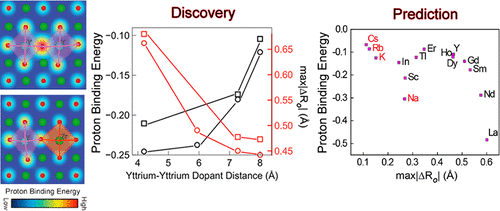当前位置:
X-MOL 学术
›
Chem. Mater.
›
论文详情
Our official English website, www.x-mol.net, welcomes your
feedback! (Note: you will need to create a separate account there.)
The Influence of Local Distortions on Proton Mobility in Acceptor Doped Perovskites
Chemistry of Materials ( IF 7.2 ) Pub Date : 2018-06-27 00:00:00 , DOI: 10.1021/acs.chemmater.8b00502 Jilai Ding 1, 2 , Janakiraman Balachandran 2 , Xiahan Sang 2 , Wei Guo 2 , Jonathan S. Anchell 2 , Gabriel M. Veith 3 , Craig A. Bridges 4 , Yongqiang Cheng 5 , Christopher M. Rouleau 2 , Jonathan D. Poplawsky 2 , Nazanin Bassiri-Gharb 1, 6 , Raymond R. Unocic 2 , P. Ganesh 2
Chemistry of Materials ( IF 7.2 ) Pub Date : 2018-06-27 00:00:00 , DOI: 10.1021/acs.chemmater.8b00502 Jilai Ding 1, 2 , Janakiraman Balachandran 2 , Xiahan Sang 2 , Wei Guo 2 , Jonathan S. Anchell 2 , Gabriel M. Veith 3 , Craig A. Bridges 4 , Yongqiang Cheng 5 , Christopher M. Rouleau 2 , Jonathan D. Poplawsky 2 , Nazanin Bassiri-Gharb 1, 6 , Raymond R. Unocic 2 , P. Ganesh 2
Affiliation

|
Optimizing proton conduction in solids remains the most promising solution for achieving intermediate temperature (∼750–1000 K) solid oxide fuel cell devices, and enabling selective membranes for H2 separation. Proton conduction, a thermally activated process, exhibits its highest rates in yttrium (Y) acceptor doped BaZrO3 at an optimal doping level of 20% Y. The presence of extended defects such as grain boundaries has typically generated a wide variability in reported conductivity values. This has hindered a fundamental mechanistic understanding of how (acceptor) doping levels correlate with the activation energy of protons to produce an optimal doping level for fast proton transport. While isolated dopants have been suggested as the primary source of proton trapping, our results indicate that it is the local dopant-density that matters. Here, we show that increasing the local dopant density promotes localized lattice distortions in the presence of point defects such as oxygen-vacancies or proton interstitials. An increasing distortion amplitude traps the point defects more strongly in the form of polarons, forming defect-clusters at higher concentrations. This leads to a monotonic increase in the activation energy (and hence a decrease in proton mobility) as observed in our measurements. The optimum doping level can now be explained as a competition between increasing proton concentration with doping levels and increasing activation energy due to defect-clusters formed by defect-polarons. Based on our findings, we demonstrate how to improve proton conductivity in doped BaZrO3, by inhibiting this dopant-lattice polaronic interaction. This approach should be generally applicable for ionic conduction in perovskite oxides such as oxygen-ion conduction in solid-oxide fuel cells and alkali-ion conduction in solid-state batteries where carriers might get trapped as defect-polarons.
中文翻译:

局部畸变对受体掺杂钙钛矿中质子迁移率的影响
优化固体中的质子传导仍然是实现中等温度(约750-1000 K)固体氧化物燃料电池设备并实现H 2分离选择性膜的最有希望的解决方案。质子传导是一种热激活过程,在掺有钇(Y)受体的BaZrO 3中表现出最高的速率在20%Y的最佳掺杂水平下,存在扩展缺陷(例如晶界)通常会在报告的电导率值中产生很大的差异。这阻碍了对(受体)掺杂水平如何与质子的活化能相关以产生用于快速质子传输的最佳掺杂水平的基本机理的理解。尽管已提出隔离的掺杂剂是质子捕获的主要来源,但我们的结果表明,重要的是局部掺杂剂的密度。在这里,我们表明,在存在点缺陷(例如氧空位或质子间隙)的情况下,增加局部掺杂剂密度会促进局部晶格畸变。畸变幅度的增加会以极化子的形式更强烈地捕获点缺陷,从而在较高浓度下形成缺陷簇。如我们的测量中所观察到的,这导致活化能的单调增加(因此质子迁移率降低)。现在可以将最佳掺杂水平解释为质子浓度随掺杂水平的增加与由于缺陷极化子形成的缺陷簇形成的活化能之间的竞争。根据我们的发现,我们证明了如何改善掺杂BaZrO中的质子传导性如图3所示,通过抑制这种掺杂剂-晶格的极化相互作用。这种方法通常适用于钙钛矿氧化物的离子传导,例如固体氧化物燃料电池中的氧离子传导和固态电池中的碱离子传导,在这些情形下,载流子可能会被俘获为缺陷极化子。
更新日期:2018-06-27
中文翻译:

局部畸变对受体掺杂钙钛矿中质子迁移率的影响
优化固体中的质子传导仍然是实现中等温度(约750-1000 K)固体氧化物燃料电池设备并实现H 2分离选择性膜的最有希望的解决方案。质子传导是一种热激活过程,在掺有钇(Y)受体的BaZrO 3中表现出最高的速率在20%Y的最佳掺杂水平下,存在扩展缺陷(例如晶界)通常会在报告的电导率值中产生很大的差异。这阻碍了对(受体)掺杂水平如何与质子的活化能相关以产生用于快速质子传输的最佳掺杂水平的基本机理的理解。尽管已提出隔离的掺杂剂是质子捕获的主要来源,但我们的结果表明,重要的是局部掺杂剂的密度。在这里,我们表明,在存在点缺陷(例如氧空位或质子间隙)的情况下,增加局部掺杂剂密度会促进局部晶格畸变。畸变幅度的增加会以极化子的形式更强烈地捕获点缺陷,从而在较高浓度下形成缺陷簇。如我们的测量中所观察到的,这导致活化能的单调增加(因此质子迁移率降低)。现在可以将最佳掺杂水平解释为质子浓度随掺杂水平的增加与由于缺陷极化子形成的缺陷簇形成的活化能之间的竞争。根据我们的发现,我们证明了如何改善掺杂BaZrO中的质子传导性如图3所示,通过抑制这种掺杂剂-晶格的极化相互作用。这种方法通常适用于钙钛矿氧化物的离子传导,例如固体氧化物燃料电池中的氧离子传导和固态电池中的碱离子传导,在这些情形下,载流子可能会被俘获为缺陷极化子。











































 京公网安备 11010802027423号
京公网安备 11010802027423号